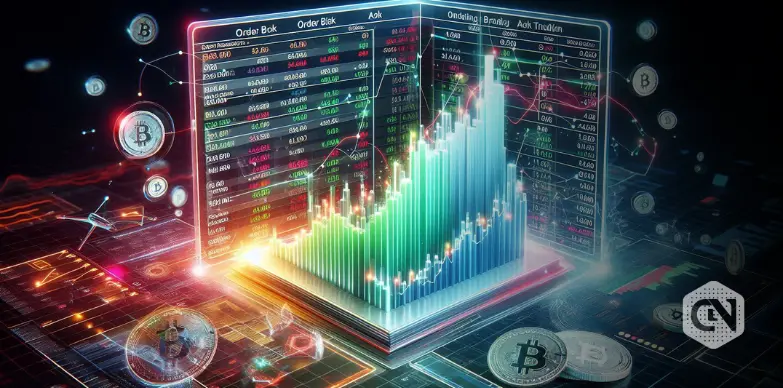Order books are an integral element of the financial markets, and can be viewed in a wide range of exchanges. When a trader places a buy or sell limit order at a set price, the order book tracks it until a matching order is found, at which point the trade executes automatically. For instance, if a trader places a buy order for Bitcoin at $50,000 and a seller lists at the same price, a trade occurs instantly without direct intervention. This is very helpful in the way of getting price discovery, and market liquidity, thus it is not a surprise to see order books as an important part of both institutional and retail participation in the cryptocurrency ecosystem.
What is an Order Book in Crypto Trading?
A crypto order book is a real-time electronic list of all pre-existing buy and sell orders in an exchange for cryptocurrencies. A crypto order book has two main components: the bid orders (which are the buy orders), and the ask orders (which are the sell orders). Each side of the book shows the price levels along with the quantity of crypto available at those prices..
For example, a bitcoin order book may have buy orders at $49,800, $49,700, and $49,600 (decreasing in value), and sell orders at $50,000, $50,100, and $50,200 (increasing in value). The difference between the highest bid and the lowest ask is called the bid-ask spread. The bid-ask spread shows the market is liquid.
An order book provides the most crucial information about a market by showing:
- Supply-demand dynamics based on order quantities
- Market depth and liquidity across price levels
- Momentum in trading through order placement patterns
- Potential support and resistance at large orders
This information helps gauge optimal entry and exit points and get a wider glimpse of market sentiment.
How Order Books Influence Liquidity
Liquidity in crypto markets to the ease with which one can buy or sell an asset without causing significant price movement. In terms of depth and structure, it is the order books that define market liquidity. A deep order book consists of many buy and sell orders at different price levels. A deep order book often indicates high liquidity. As a result, depth directly impacts market stability. Low liquidity can lead to slippage, where traders get less favorable prices due to limited matching orders. Meanwhile, bid-ask spreads reflect levels of liquidity; smaller spreads reflect high liquidity, whereas wider spreads reflect lower liquidity and potentially higher trading costs.
The Connection Between Order Books and Trading Volume
Trading volume represents the total amount of cryptocurrency traded within a specific time period, reflecting market activity and investor interest. Generally, active order books will have many open orders contributing to the volume of trading in potential matchings. For Bitcoin, for example, a more densely populated order book around current price clusters triggers trading by giving buyers and sellers greater chance of matching on price. The ubiquitous dynamics of the top of the book have higher volumes, leading to more traders by virtue of more trader orders, and the order book becomes far more enriched, as one trader ordering a large quantity of trades will lead to many more orders in the order book. Thin order books will often correlate with lower volumes since fewer matching conditions will be available.
Factors Affecting Order Book Depth and Activity
Order book depth and activity vary depending on several key factors:
- In bull markets, order books often show greater depth on the buy side, as traders expect prices to rise. In bearish conditions, such as sell-side pressure, it outweighs buying orders.
- Major market events have a substantial impact on the order book composition. For example, positive news, such as institutional adoption or favorable regulations, could flood the order book instantly with buy orders, while negative news might include security breaches that trigger a massive influx of sell orders.
- Traders’ behavior will also determine the dynamics of order books; large traders often become “whales,” who can affect huge portions of depth by simply opening a massive order on a selected price level and creating a zone of support or resistance.
- Trading bots frequently place and cancel orders based on programmed strategies, sometimes creating artificial depth or temporary thin spots.
Practical Tips for Traders Using Order Books
Some practical tips for traders on how to trade using order books are provided below:
- Analyze the bid-ask spread; tighter spreads generally indicate higher liquidity and more efficient trading conditions.
- Focus on the volume of orders at different price levels to track potential areas of strong support and resistance.
- Visualize order book data to reflect the different trends of the market over time and thus make correct predictions.
- Keep an eye out for changes in order sizes and positions that could provide insight into the entire market.
- Use real-time order book information in trading strategies to better perceive the decision-making process.
- Adjust your strategy based on changing order book dynamics, as conditions can shift rapidly.
Also Read: Understanding Liquidity and Volume in Crypto Exchanges: Key Factors for Traders
Conclusion
Order books are a foundational concept in crypto markets, serving as the bridge between trading volume and liquidity. They contain fundamental ingredients in crypto exchanges, allowing access to real-time information regarding market depth, trader sentiment, and even price discovery processes. It is important to note that learning how to read order books is essential for every user in the world of trading, from the beginner to the seasoned investor. The order book presents essential signals for the markets and helps find good trading opportunities.
See less

